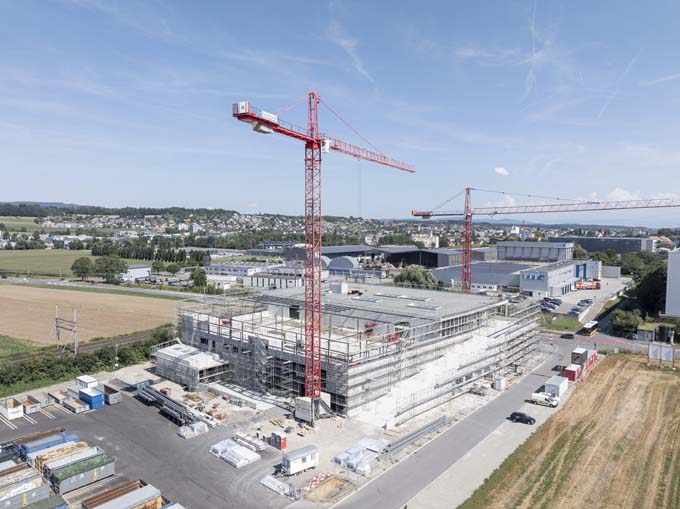Protection against natural hazards: Net barriers instead of concrete
Lightweight, flexible and highly resilient: net barriers against debris flows and hillslope debris flows have only been around for a few years. Where is their use suitable and how are they planned and dimensioned? A new WSL report financed by the Federal Offices for the Environment and Roads discusses experiences with the new types of protective nets and is intended to support authorities, project managers and engineering offices in their decisions.

After heavy rain, torrents can suddenly cause huge mudslides with boulders - so-called debris flows - to roll down to the valley. In steep terrain, entire slopes can liquefy and start moving, as so-called hillslope debris flows. Both processes can reach speeds of over 50 kilometers per hour and bury houses, roads or railroad lines. In the Alpine country of Switzerland, in addition to other measures, protective structures reduce the risk of damage from these sudden and highly destructive natural events in many places. In most cases, these are massive walls or dams made of reinforced concrete or earth material.
Protective nets are versatile
But for about ten years now, there has been an alternative on the market: flexible protective nets made of steel cables or high-tensile steel wire. They are cheaper to erect, take up less space, blend better into the landscape and could replace or supplement many a rigid concrete barrier. A team of authors from the Swiss Federal Institute for Forest, Snow and Landscape Research (WSL), the canton of Appenzell Ausserrhoden and engineering firms now provides an overview and recommendations on their use and maintenance in a new practical guide.
Flexible protective nets as rockfall barriers or snow nets have already been established worldwide for decades. The performance of the net constructions has been significantly improved since then, suggesting that they can also withstand the enormous forces of debris flows and hillslope debris flows. Due to their flexibility and the net structure, protective nets are particularly suitable for taming these natural hazards. First, the deformation of the net and built-in braking elements absorb the force of the boulder masses, then the water flows through the meshes, compacting the material that remains behind. Together, this increases the braking and retention effect.
Together with WSL, a development team from the company Geobrugg AG in Romanshorn (TG) optimized existing rockfall protection systems for the special loads of debris flows and hillslope debris flows as part of a project co-funded by the federal government between 2005 and 2011. They tested the newly developed protective nets in a large-scale trial in the Illgraben near Leuk-Susten (VS), where debris flows are particularly frequent. Further projects with artificially triggered hillslope debris flows followed. Other suppliers developed similar products during the same period, in some cases also in collaboration with universities or research institutes.
Since 2007, around 80 debris flow protection nets and 30 slope debris flow protection nets have been installed in Switzerland. In practice, their relatively fast and simple installation has proved to be one of the greatest advantages over rigid concrete structures. Components and equipment can be transported by helicopter to areas that are difficult to access. The construction time is usually limited to a few weeks, which also makes them attractive as an immediate measure. Several net barriers can be built one after the other to increase the retention volume.
The previous installations provided valuable experience for the operation and maintenance of such constructions. Occasionally, damage occurred to the net barriers, which provides indications of the measures that can be taken to avoid this and what could be optimized in the future.
Heavy rain becomes more frequent
If permafrost thaws and heavy precipitation increases as a result of climate warming, debris flows and hillslope debris flows are likely to become more frequent and more intense. Therefore, the use of protective nets could be useful more often. "As an immediate measure or even as protection for a single road or building, protective nets can be installed within a short time," says Christoph Graf, geomorphologist at WSL and co-author of the practical guide. In addition, protective nets can supplement existing protective structures or, as special structures, also hold back driftwood. "Due to their diverse application possibilities, protective nets are often an attractive option compared to rigid concrete structures; therefore, this technology should definitely be evaluated in the local planning of measures in an area at risk."
The Swiss Federal Institute for Forest, Snow and Landscape Research (WSL) was involved in the commission from the Federal Office for the Environment (Bafu) and the Federal Roads Office (Astra) to assess the potential of the new protective networks from a technical, economic and ecological point of view. The main focus was on the concrete application and dimensioning as well as chances and limits of the network barriers. The results are published in the new WSL report "Practical help for debris flow and hillslope debris flow protection nets". published.









